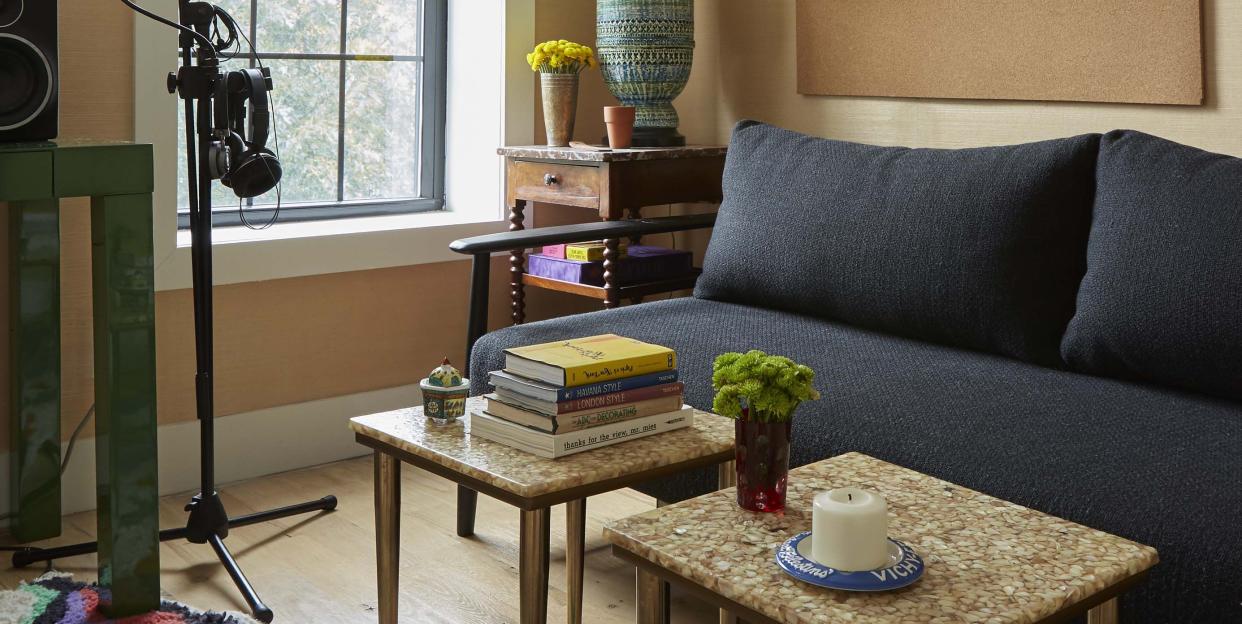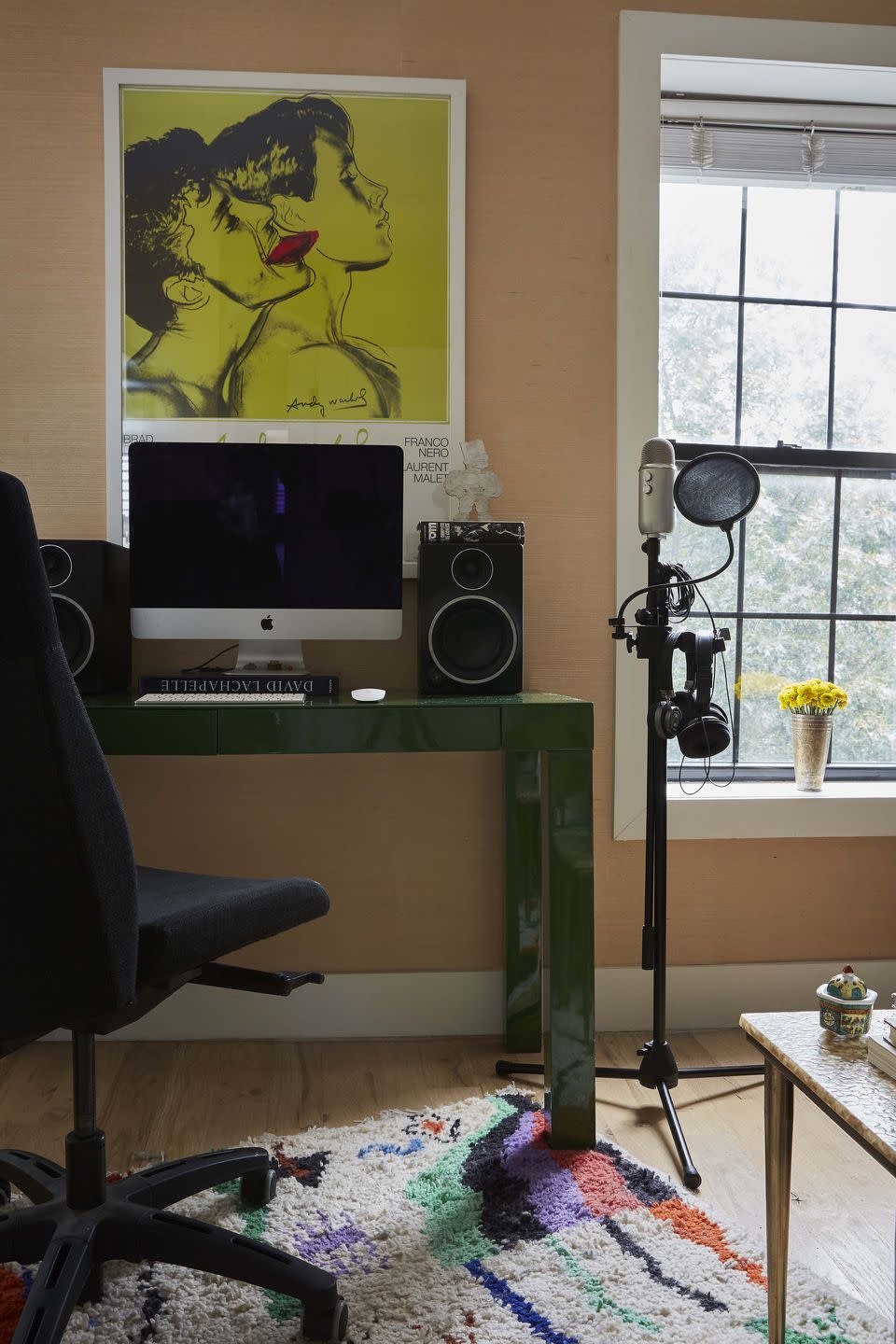See How This Designer Turned a Rarely Used Room Into a Functional Home Office, on a Budget

Moving in with a partner can inspire changes in decor—will you do a quick refresh, a more involved renovation, or invest in some big-budget pieces together? But when cohabitation happens right before a once-in-a-century pandemic and both parties work from home 24/7, some daydreams have to be put on hold to deal with reality. Interior designer Chris Bletzer and his boyfriend Jordan made the cohabitation leap at the end of 2019, and in the “Great Before,” as Bletzer calls it, they had different plans for the interiors of their Brooklyn brownstone.
“Once the pandemic hit, we just put fuel to the fire and decided, like so many people, to reevaluate the space altogether,” he says. Here’s how—and why—Bletzer transformed their guest bedroom into a super functional home office, and every little design trick he used to do it.
Design a room you'll actually use
According to Bletzer, the decision to make changes to their guest room actually started in his and Jordan’s bedroom. Their queen-size frame was beginning to feel too small—not surprising, with Jordan clocking in at 6’5”—and on top of that, their main desk setup was located there, too. (Not ideal for work-life balance.)
“It just felt really claustrophobic, sleeping and working in the same space,” Bletzer says.
And even though he felt “crazy lucky” to have a guest bedroom in a city like New York, where square footage is always tight, it seemed frivolous to have a bedroom set up for guests that wouldn’t be arriving any time soon. “We committed to starting from scratch in both spaces and then everything just took off from there.”
Find a way to break up space, even when you’re short on it
Bletzer fervently believes that any space, no matter its size, can serve several functions. He invites someone who is contemplating how to maximize their options to think about everything they’d want to do, and not compromise. The best way to get going is to start a wish list, he says, and make note of the essentials you’d need for it. Whether that’s furniture, square footage, or accents, you can figure out if you can fit it all or you need to make some items work double-duty.
“With enough creativity, you really can check all the boxes,” the designer adds.
In the case of their home office, they hoped to be able to work, read, take video calls, make music, and also host guests in the future.

By dividing their home office into three separate areas—work, lounge, and a transitional space—they were able to accommodate all of their needs. A main desk, with a computer and recording gear, makes it easy for Jordan to do his work on a daily basis. An antique chair with a low seat near a window provides an escape outside of work hours. “If you’re sitting in it you can only see the trees and skyline, and you kind of miss all the stuff happening on the street,” Bletzer says. “It kind of feels like you’re in a tree house when you’re sitting there, so it’s a bit of a dreamy perch.”
And lastly, a convertible sofa doubles as a guest bed when needed, and Bletzer often does work there at a table he snagged from Brimfield in years past. Above the sofa, he hung two sheets of cork to use as “giant mood boards” for his work. He married each of the areas by laying down a colorful Moroccan rug diagonally. “It just looks more interesting, but from a practical perspective, it means that all three ‘zones’ are pretty much covered.”
Stray away from white as a video background
While Bletzer is self-proclaimed “obsessed” with white or chalky walls in the rest of his home, he asserts that it can actually be a tricky background for work calls. “Almost everyone looks better against a warmer-toned background,” he adds.
For their home office, he decided to work with a warm beige grasscloth wallcovering. “This is kind of double duty as the paper is pretty thick with a lot of texture and actually has an acoustic benefit as well, blocking out a lot of the echo,” he notes. “It was a win-win.”
Give yourself a budget—and don't go over
“During the height of the pandemic, we were super cautious about getting deliveries and wanted to be as respectful as possible for the safety and wellbeing of the delivery workers,” Bletzer says. For that reason, he and Jordan ordered solely from a few key places—and felt in particular that budget retailer IKEA was being responsible about deliveries and employee safety. While they can often be dinged for difficult assembly, Bletzer called out the quality of and simple instructions for their MALM line.
“I am easily the least handy person in the world, but I honestly thought putting all of that stuff together, even a pretty sizable chest of drawers, was a breeze.”
Additionally, Bletzer employed DIY on a pair of corkboards to create an oversized visual space to think through products.
How to DIY a Cork Inspiration Board
And if you need visual guidance, see here:
Order a roll of cork, either online or at an art supply store
Weigh them down for 24 to 48 hours to flatten out the curl
Pick up pre-cut or MDF boards from a place like The Home Depot—Bletzer had a 4x8’ sheet cut in half
Affix the boards to your wall with a drill and the appropriate screws, and then apply vinyl flooring adhesive to the front.
Then, use a rolling pin or large bottle to get the cork to stick to the glue
Don’t forget the "home" in home office
“I think it’s super important not to forget the home part of a home office,” Bletzer advises. “You’re likely to spend 8-plus hours a day in that space, so you deserve to be in a beautiful setting.” Furnishing with this idea top of mind will make the end result a place you actually want to retreat to, for a work session or something more.
Beyond considering the best desk or chair, take note of the number of electrical outlets, how many layers of lighting you’ll want or need, and if you have space for other items like a printer or filing cabinet.
Additionally, he says, you’ll want to be comfortable! Hone in on what brings you joy and make space for that. Grab a soft blanket to throw over your desk chair or, if you have the room, add a small loveseat or lounger and side table. Or bring in personal objects that have an important meaning in your life. For example, In their home office, Jordan wanted an alter-type area where he could put all of his sacred things.
“It just adds this whole other element to the space and somehow makes me feel calmer just looking at it,” says Bletzer.
Follow House Beautiful on Instagram.
You Might Also Like

